Stay in the know on all smart updates of your favorite topics.
Demoday #28: Designing for Circularity in the Port of Amsterdam

During Demoday #28, we focused on one of the key challenges in the circular transition: how can we make the Port of Amsterdam fully circular?
The Amsterdam port is one of the largest in Europe. It functions as a major energy hub, where fossil fuels still play a central role, and as an industrial hub, where massive flows of raw materials pass through. The City of Amsterdam has set the ambitious goal of becoming fully circular by 2050. This means the port must transform as well. This is a complex and far-reaching task that requires collaboration and innovation.
In this work session, we zoomed in on circular design: how can we make products and processes circular from start to finish?
A closer look at the port
James Hallworth, Commercial Manager at Port of Amsterdam, opened the session by taking the group on a tour through the world of the port. Located in the western harbour area, the port has two main responsibilities. First, it ensures the smooth and safe handling of all maritime traffic on behalf of the City of Amsterdam. Second, it manages and develops the land and industrial areas around the harbour.
To tackle circularity, Port of Amsterdam applies industrial ecosystem thinking. In nature, waste does not exist, and the same principle should apply here. The port aims to build collaborative networks between companies, where waste flows from one company becomes raw materials for another. There is already significant activity around recycling and recovery, but more can be done in higher-value strategies on the R-ladder, such as repurposing, remanufacturing, and refurbishment. Circular by design is a key concept in this shift.
The port is transitioning from measuring success in tons to measuring added value. This shift also means thinking differently about space: circular systems require space to receive, process, and recover valuable materials from waste streams.
Getting hands-on with circular design
Creating a fully circular production process is easier said than done. That’s why we worked through two real-world cases: construction materials and e-bikes. Participants split into groups and explored what a truly circular production process might look like. We also explored the potential role the port could play as an enabler of circular supply chains.
Some key takeaways from the session:
• Material passports: A digital document containing material properties and origin can greatly simplify recycling and reuse.
• Monomaterials: Products made from a single type of material are much easier to separate and recycle at the end of life.
• Smart synergies: Mapping which companies can use each other’s waste flows as input can unlock huge circular potential.
• Financial incentives: Right now, circular processes are often more expensive than linear ones. Smart financial mechanisms could help bridge that gap.
• E-bike challenges: In the case of e-bikes, batteries were flagged as a challenge. Recycling them is still very difficult, and since they are mostly produced outside of Europe, it’s hard to have control over the production process.
This session invited participants to take a step back and view products through a circular lens. The port has the potential to become a key player in the circular transition, but to get there, it will need ideas, insights, and input from across the network.
<strong>Do you have ideas on how the Port of Amsterdam can become more circular? Or would you like to contribute to future sessions? Get in touch with Noor at noor@amsterdaminchange.com. A big thank you to James Hallworth from Port of Amsterdam for bringing this challenge to the network, and Yanti Slaats (Amsterdam University of Applied Sciences) for moderating the session.</strong>
“We’re not just creating technology for cities—we’re creating better cities for people.” From Global Goals to Local Action: How Amsterdam Is Building a Smarter, Fairer City
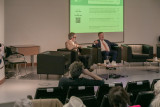
As the world grapples with massive challenges—climate change, rapid urbanisation, digital disruption, and growing inequality—some cities are not waiting for top-down solutions. They are rolling up their sleeves and experimenting with new ways to improve life for everyone, block by block. Amsterdam is one of those cities.
That’s why I was proud to share Amsterdam InChanges approach to smart, inclusive urban innovation at the #CIPPCD2025 conference in Aveiro.
Through our open innovation platform, <strong>Amsterdam InChange</strong>, the city has become a global leader in turning lofty global ambitions into practical, local action. But Amsterdam’s model isn’t built around flashy tech or utopian blueprints. Instead, it’s grounded in an essential question: How can we use innovation to improve people’s everyday lives?
Local Action for Global Challenges
Amsterdam understands that the climate crisis, digital transition, and social inequality can’t be solved by government alone—or by technology alone. That’s why it launched Amsterdam Smart City in 2009 as a public-private partnership. What began as small-scale energy-saving pilots has grown into a community of over 8,500 members, coordinating more than 300 projects across the city and beyond.
The approach is rooted in co-creation. Citizens, companies, knowledge institutions, and government actors come together to design, test, and scale solutions that serve the public good. The values that guide the network are clear: people first, openness, transparency, learning by doing, and public value.
The Doughnut as a Compass
Amsterdam was the first city in the world to embrace Doughnut Economics as a guiding framework. The “City Doughnut,” developed with economist Kate Raworth, helps policymakers balance the city’s ecological footprint with the social foundations that all citizens need: housing, education, health, equity, and more. It’s a tool to align every local decision with both planetary boundaries and human dignity.
This framework has inspired circular construction strategies, neighbourhood energy co-ops, and more inclusive procurement policies. It shows that global concepts can become real when grounded in local practice.
Making Innovation Inclusive
One of Amsterdam’s core beliefs is that smart cities must be <strong>inclusive cities</strong>. That means tackling issues like <strong>mobility poverty</strong>, where rising transport costs and digital-only services make it harder for low-income or elderly residents to get around.
Through the <strong>Mobility Poverty Challenge</strong>, Amsterdam partnered with the Province of North Holland and researchers from DRIFT to understand where and how exclusion occurs—and to design better public mobility systems. Pilot ideas like a “Mobility Wallet” (a subsidy for essential travel) and more inclusive digital apps emerged from real conversations with affected residents.
The same inclusive mindset guides Amsterdam’s digital transformation. In the suburb of Haarlemmermeer, officials flipped the script on e-government. Instead of asking citizens to become “digitally skilled,” they asked how government systems could become more <strong>humane</strong>. This led to simplified interfaces, better access to services, and ultimately more trust.
Responsible Tech and Energy from the Ground Up
Tech transparency is another pillar of the Amsterdam model. The city runs the world’s first <strong>Algorithm Register</strong>, giving the public insight into how AI and automated systems are used in services—from traffic enforcement to housing applications. Anyone can access this register, offer feedback, and better understand how digital decisions are made.
In the energy space, the city supports both bold innovation and careful upscaling. At the <strong>Johan Cruijff ArenA</strong>, used electric vehicle batteries store solar energy, powering concerts and matches with clean backup power. At the same time, a coalition of partners led by Amsterdam InChange is working to scale up Local Energy Systems by collecting lessons learned and creating a toolkit for community-led energy.
What Makes It Work?
If there’s one secret to Amsterdam’s success, it’s the governance model: small, neutral facilitation teams guiding large multi-stakeholder coalitions, anchored by public trust and shared purpose. Regular Demo Days allow project teams to showcase progress, get feedback, and adapt. This culture of transparency and iteration helps avoid the so-called “innovation graveyard,” where pilot projects go to die.
The city also embraces failure—as long as it’s shared and learned from. Reports like “Organising Smart City Projects” openly list lessons, from the importance of strong leadership to the need for viable business models and continuous user involvement.
An Invitation to Other Cities
Amsterdam’s smart city is not a blueprint—it’s a mindset. Start with your biggest local challenge. Bring the right people together. Make space for experimentation. Build bridges between local and global. And, above all, put citizens at the centre.
As international smart city ambassador Frans-Anton Vermast puts it: “We’re not just creating technology for cities—we’re creating better cities for people.”
The III International Conference on Public Policies and Data Science
Building local mini-economy within planetary boundaries

Scroll naar beneden voor de Nederlandse versie
Growth is an end in itself, dictates the current economic model. For only growth would keep our economy going and be indispensable to further sustainability. At the same time, our planet is being depleted by this drive for green growth.
Is it time to abandon economic growth as a social ideal? And then what are workable, more social alternatives?
More and more business owners are opting for sustainable operations. They settle for less financial gain to do valuable work with positive social and environmental impact. The rise of the commons movement, housing-, energy- and food cooperatives, as well as social initiatives in health and welfare, show that people want to stand together for values other than financial gain.
Achievable and real alternatives
New economic models offer different perspectives for considering the economy as part of a society. They offer tools to make that economy more equitable and sustainable. Yet the new economic thinking is still often dismissed as unrealistic and unachievable. Only by trying out these theories in practice can we demonstrate that these are real alternatives.
New economic thinking, New economic acting
To experiment with new economic theory and models in practice, the Amsterdam Economic Board has started the New Economic Models exploration. In April, we introduced the living lab project “New Economic Thinking, New Economic Acting” at the Marineterrein in Amsterdam. In this we work on socio-economic experiments, together with AMS Institute, AHK Culture Club, And The People, Bureau Marineterrein, Kennisland, The Next Speaker and the knowledge coalition ‘Art, Tech & Science’.
The Marineterrein is the ideal place to do this because it is an official experiment site. Moreover, companies located here are often already working on circular and social projects. Cultural institutions and organisations at the Marineterrein, in turn, can represent what thriving without economic growth could look like and fuel our desire for a new economy.
-----------------------------------------------------------------------------------------------------------------------
Bouwen aan lokale mini-economie binnen planetaire grenzen
Groei is een doel op zich, dicteert het huidige economische model. Want alleen groei zou onze economie draaiende houden en onmisbaar zijn om verder te verduurzamen. Tegelijkertijd raakt onze planeet uitgeput door die drang naar groene groei.
Wordt het tijd om economische groei als maatschappelijk ideaal los te laten? En wat zijn dan werkbare, socialere alternatieven?
Steeds meer ondernemers kiezen voor een duurzame bedrijfsvoering. Zij nemen genoegen met minder financiële winst om waardevol werk te kunnen doen, met positieve sociale en ecologische impact. De opkomst van de commons-beweging, woon-, energie- en voedselcoöperaties en maatschappelijke initiatieven in zorg en welzijn, laten zien dat mensen zich samen sterk willen maken voor andere waarden dan financieel gewin.
Haalbare en reële alternatieven
Nieuwe economische modellen bieden andere perspectieven om de economie als onderdeel van een samenleving te beschouwen. Ze bieden handvatten om die economie rechtvaardiger en duurzamer in te richten. Toch wordt het nieuwe economisch denken nog vaak weggezet als onrealistisch en niet haalbaar. Alleen door deze theorieën in de praktijk uit te proberen kunnen we aantonen dat dit reële alternatieven zijn.
Nieuw economisch denken, Nieuw economisch doen
Om te kunnen experimenteren met nieuwe economische theorie en modellen in de praktijk, verkent Amsterdam Economic Board deze in de verkenning Nieuwe economische modellen. In april introduceerden we het proeftuinproject ‘Nieuw economisch denken, Nieuw economisch doen’ op het Marineterrein in Amsterdam. Hierin werken we aan sociaaleconomische experimenten, samen met AMS Institute, AHK Culture Club, And The People, Bureau Marineterrein, Kennisland, The Next Speaker en de kenniscoalitie ‘Art, Tech & Science’.
Het Marineterrein is de ideale plek om dit te doen, omdat het een officieel ‘experimentterrein’ is. Bovendien zijn de hier gevestigde bedrijven vaak al bezig met circulaire en sociale projecten. Culturele instellingen en organisaties op het Marineterrein kunnen op hun beurt verbeelden hoe bloei zonder economische groei er uit kan zien en ons verlangen aanwakkeren naar een nieuwe economie.
Samenwerken aan transitievraagstukken; wat is er nodig? - Opbrengsten van het Amsterdam Smart City partnerdiner 2024
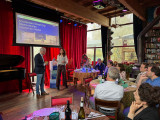
Als Amsterdam Smart City netwerk bijten we ons vast in complexe stedelijke transitievraagstukken. Ze zijn complex omdat doorbraken nodig zijn; van kleine doorbraakjes, tot grotere systeem doorbraken. Denk aan bewegingen rond; organisatie-overstijgend werken, domein-overstijgend werken, en van competitief naar coöperatief. Als netwerk zetten we samenwerkingsprojecten op waarin we gaandeweg ondervinden met wat voor barrières we te maken hebben en wat voor doorbraken er nodig zijn.
Tijdens ons jaarlijkse Partnerdiner op 2 april, hadden we het samen met eindverantwoordelijken van onze partnerorganisaties over de strategische dilemma’s die spelen bij transitievraagstukken. Als gespreksstarters gebruikten we onze lopende onderwerpen van 2024: De coöperatieve metropool, de ondergrond, de circulaire metropool en drijvende wijken. De gesprekken aan tafel gingen echter over wat er aan de basis staat van het werken aan transitievraagstukken. Zo ging het bijvoorbeeld over; het samenwerken aan visies en scenario’s, leiderschap, burgerlijke ongehoorzaamheid en de kracht van coöperaties. In dit artikel bespreek ik beknopt een aantal onderwerpen die onder de aandacht werden gebracht door onze gasten.
Belangen en visie organiseren
Bij een vraagstuk of onderwerp als de ondergrond, gaan we het al snel hebben over de data en de oplossingen. Dat is ‘te makkelijk’. Technisch gaat het allemaal wel kunnen, maar als we daar te snel beginnen met de oplossing lopen we over een aantal jaar weer vast. Het is belangrijk om eerst een stapje terug te doen en een gedeeld belang en gedeelde visie te organiseren.
Hoe je belanghebbenden verzamelt, en de methode om tot een gedeelde visie te komen, dat is wat meer aandacht verdient. Neem het ondergrond vraagstuk als voorbeeld. Op welke schaal organiseer je daarvoor de belanghebbenden? Aan de oppervlakte hebben we Gemeentelijke en Provinciale grenzen, maar in de ondergrond liggen netwerken van kabels en leidingen die op andere schaal zijn geïnstalleerd en hebben we te maken met bodemtypologieën met verschillende behoeften.
Samen voorstellen en voorspellen
Dat waar je naartoe wilt werken, dat moet van iedereen voelen. Het is belangrijk om een setting te creëren van gedeeld eigenaarschap, waarin iedereen zich ook gehoord voelt, en dat je voelt dat de mensen met wie je gaat samenwerken ook voor jouw belangen op zullen komen. Om samen tot een visie te komen, is het belangrijk om te werken aan scenario’s en die samen te doorleven. Je moet het dan niet alleen hebben over waar je heen wilt, maar ook uitwerken wat er gebeurt als je niets doet of als het helemaal verkeerd uitpakt.
De scenario’s zouden op waarden moeten rusten. Het beeld wat bij de scenario’s hoort is veranderlijk, maar de waarden niet. Samen ben je continu in samenspraak over wat de waarden betekenen voor het verhaal dat je creëert.
Leiderschap en een interdisciplinaire werkwijze
Transitievraagstukken en bovenstaande aanpakken verdienen een bepaald soort leiderschap. Zo zou een leidinggevende bijvoorbeeld een veranderlijke en faciliterende houding moeten tonen, en moet hij/zij vanuit waarden werken die inspireren en verbinden. Het zou meer moeten gaan over het faciliteren van doeners, het stimuleren van doelgericht samenwerken in plaats van taakgericht en ruimte bieden voor menszijn en persoonlijke expertises. Met dit laatste wordt verwezen naar een stukje burgerlijke ongehoorzaamheid. Om dingen die we belangrijk vinden in gang te zetten moeten we soms even los kunnen denken van onze organisatiestructuren en functies. We zouden wel wat vaker mogen appelleren aan ons menszijn.
Meer faciliteren en minder hiërarchie helpt ons om beleid en praktijk dichter bij elkaar te brengen, en om van competitief naar meer coöperatief te bewegen. Als je naar de uitvoering gaat mag de kracht verplaatsen naar de uitvoerders. De machtsverschuivingen tussen leidinggevenden en de doeners, met specifieke rollen en expertises, mag in een constante wisselwerking rond gaan.
Ook interdisciplinair samenwerken aan transitievraagstukken zal nog meer moeten worden gestimuleerd, en misschien wel de norm moeten worden. Bij overheden en bestuurders bijvoorbeeld, zijn transitie thema’s verdeeld over domeinen als energie, mobiliteit, etc. maar de vraagstukken zelf zijn domein overstijgend. Als voorwaarde zou je kunnen stellen dat je altijd twee transities aan elkaar moet koppelen. We zouden meer inspirerende voorbeelden moeten laten zien waarbij verschillende domeinen en transities aan elkaar worden gekoppeld, door bijvoorbeeld overheden.
Publiek-privaat-civiel
Publieke, private en civiele partijen zouden nog meer naast elkaar aan tafel mogen, in plaats van tegenover elkaar. Bedrijven kunnen verzuild zijn, of zich zo voelen, en zouden nog meer om zich heen kunnen kijken en samenwerken. Niet alleen met overheden, maar ook met civiele organisaties. Er zijn vaak meer gezamenlijke belangen dan we denken.
In een beweging naar niet-competitief samenwerken kunnen coöperaties een belangrijke factor zijn. Wanneer je meer autoriteit bij coöperaties neerlegt, weet je zeker dat er in de basis voor een wijk, een stad, haar inwoners, een publiek belang wordt gewerkt. Er liggen dan ook veel kansen bij een faciliterende houding vanuit de overheid naar coöperaties toe, en in de samenwerking tussen bedrijven en coöperaties.
Er zijn tijdens dit diner veel onderwerpen aan bod gekomen waar we met het netwerk mee aan de slag kunnen in onze programmering. De input wordt gebruikt voor onze lopende vraagstukken en we gaan de komende tijd in gesprek met partners om te kijken of we van start kunnen met verdiepende sessies of het ontwikkelen van methoden op (enkele van) deze onderwerpen.
<em>Wil je doorpraten over deze onderwerpen, met ons - of een van onze partners? Mailen kan naar pelle@amsterdamsmartcity.com*</em>
Unlocking circular innovation: Launch of the Circular Innovation Collective program guide

Exciting news! We're happy to announce the launch of the Circular Innovation Collective program guide!
Launched during the #WeekofCircularEconomy2024, the guide is a practical roadmap for local governments to foster circular innovation within their cities and regions.
Gathering insights from its first pilot program in the Metropolitan Region Amsterdam, the guide offers practical and comprehensive instructions for scoping out, designing, and executing local innovation programs. Here’s what Egon van Wees from Amsterdam Impact said about the program:
"To transition to an impact economy we need to radically change our approach. We need to work with front runners and entrepreneurs that tackle societal challenges and influence the broader ecosystem. With the CIC approach you can do just that.” - Egon Van Wees, Program Coordinator, Amsterdam Impact (CIC program Funder).
Wanting to empower other cities and regions across Europe, the CIC is sharing its FREE program guide to accelerate the transition to the new circular economy.
Download the guide in the link below
The Circular Innovation Collective is a consortium of impact-driven organizations initiated by Metabolic, Impact Hub Amsterdam, and Bankers without Boundaries. With the support of the City of Amsterdam (Amsterdam Impact), The DOEN Foundation, and Goldschmeding Foundation, this initiative specifically targeted achieving 70% circular textiles in the Metropolitan Region Amsterdam by 2030. Demonstrating the potential for impactful change, CIC is now dedicated to sharing its knowledge, experience, and strategies in an open-source manner.
#circularinnovationcollective #circularcities #ventures
Amsterdam Region’s Insights on Local Green Deals during COP28
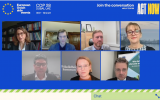
Participating in a COP28 side event organized by the European Commission, the Amsterdam Region delved into Local Green Deals as instrument for achieving the green transition. The primary goal for the session was to uncover actionable strategies and prerequisites essential for fostering public-private collaboration to realize the sustainability transition. Marja Ruigrok, vice-mayor for the municipality of Haarlemmermeer, represented the Amsterdam Region alongside political and business leaders from Braga (Portugal), Aalborg (Denmark) and Skelleftea (Sweden).
Commencing the session, Valentina Superti, DG for Internal Market, Industry, Entrepreneurship, and SMEs at the European Commission, highlighted Europe's ambition to become the first climate-neutral continent by 2050. This necessitates a transformative shift towards sustainability, digitalization, and resilience, which is why the Commission is introducing critical legislation like the Net-Zero Industry Act and the Critical Raw Materials Act.
Ruigrok shared insights from the Amsterdam Metropolitan Region’s efforts in establishing Local Green Deals, emphasizing her role as political ambassador and champion for the Green Deal Bikes initiative. She stressed the importance of cycling, explaining that despite its reputation as a cycling paradise, approximately 20% of young people in the Amsterdam Region can not ride a bike: “If you don’t learn to ride a bike at a young age, you are also much less likely to use a bike for commuting later in life. That’s why in this Green Deal, we stimulate young people to learn to ride bikes, and encourage employers to support commuting by bike. This is crucial because employees who bike take on average 2.5 fewer sick days compared to those who don’t bike.”
Reflecting on success factors, Ruigrok emphasized the need for political commitment, and clear project ownership: "From a political point of view, you need long term commitment, and you have to create ownership. Someone has to take ownership and say ‘this is my project.’ This might be a governmental agency, a company, a knowledge institution, or civil society organisation - but someone has to take the lead. Otherwise, you will continue to talk, and nothing will happen."
Throughout the session, participants provided practical insights and recommendations for fostering successful public-private collaborations in general, and Local Green Deals in specific:
- Lasse Frimand Jensen, mayor of the City of Aalborg, emphasized the necessity of accountability mechanisms: “Mutual commitment is necessary and there must be mechanisms in place to keep each other accountable.”
- Ricardo Rio, mayor of City of Braga and Member of the European Committee of the Regions, highlighted the role of local authorities in mobilizing capacity and engaging stakeholders: “Local authorities need to have the spirit to engage stakeholders and shape partnerships. We also need governance models that tranced political cycles, and that allow people to participate and hold us accountable.”
- Jens Broberg, representing the business sector, emphasized the urgent need for appropriate incentives: “Governments must use policy frameworks to incentivize and regulate businesses and industry towards a green economy.”
- Evelina Fahlesson, vice-mayor of Skelleftea Municipality emphasized the need for open and honest dialogue: “As a municipality, you have to be open about your challenges and willing to start a dialogue with your citizens and companies. Use procurement and new financing models as tools to implement a shared vision.”
- David Nordberg, from Skanska Sweden, encouraged business leaders to align their business models with sustainability ambitions: "Be brave: try new ways of doing business and work in collaborations. In the long term, there is no conflict between sustainability and the economy."
The session highlighted the pivotal role of collaborative multi-stakeholder partnerships in achieving the green transition, emphasizing sustained political commitment, robust governance structures transcending political timelines, and policy frameworks incentivising sustainable businesses.
In the context of COP28, the true challenge lies in replicating these successful approaches on a wider scale, extending beyond the relatively affluent European context to a global landscape with more limited resources. In many regions, the urgent and acute impacts of climate change are already pervasive, amplifying the need for swift, comprehensive action. This necessitates a global and concerted effort of nations and industries, to surmount the hurdles posed by resource scarcity and varying levels of socio-economic development. This calls for collaboration not only within regions but across continents, fostering knowledge-sharing, technology transfer, and collective efforts in tackling climate challenges. The urgency of the climate crisis demands a united global front, where the lessons learned and successes achieved in Local Green Deals can serve as guiding principles towards a more sustainable and resilient future for all.
Hoe brengen we weer lucht in het stikstofvraagstuk?
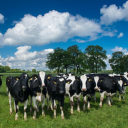
De problematiek rondom stikstof is complex en ingrijpend. Ze is diep verweven met uiteenlopende sectoren, belangen en maatschappelijke discussies. Van de veehouderij tot de industrie, van de woningbouw tot de luchtvaart: de opgave die er ligt is enorm — ook voor overheden. Tegen welke dilemma's lopen zij aan? Hoe is de onderlinge rolverdeling? En welke concrete stappen kunnen overheden zetten om zaken weer vlot te trekken? Een dubbelinterview met Deloitte’s Gijsbert Duijzer, Partner Real Estate bij Deloitte, en Mario Kortman, Director Major Programs Public Sector bij Deloitte.
Gijsbert Duijzer kent de stikstofproblematiek op het platteland van binnenuit. Hij heeft in Wageningen gestudeerd en woont op een boerderij in de Gelderse Vallei: nergens in Nederland is de stikstofopgave groter dan daar. In zijn directe omgeving ziet hij veehouders op dit moment worstelen met hun toekomst-perspectief en signaleert hij veel wantrouwen in de (rijks)overheid.
Mario Kortman heeft uitgebreide ervaring in het begeleiden van complexe en politiek gevoelige dossiers voor de rijksoverheid, onder meer voor de ministeries van Economische Zaken, Sociale Zaken en Financiën. Hij is op z'n best als gangmaker van grootschalige transformaties voor beleidsdepartementen en uitvoeringsorganisaties.
Om te beginnen, waar zit de grootste uitdaging?
Kortman: "In de kern draait het om de vraag: hoe kom je tot een gebiedsgerichte aanpak die werkt? Hoe zorg je dat rijk, provincies en gemeenten elkaar gaan vinden in het belang van de regio? En dat al die verschillende lagen van stakeholders ook echt met elkaar gaan samenwerken? Dat organiseren is bij stikstof al extreem ingewikkeld. In die dynamiek spelen ook technische aspecten een rol. Zoals met wat voor model je stikstof meet en of de uitkomst van zo’n model zwart of wit is. Als je daarover een knoop hebt doorgehakt en een fragiele balans hebt gevonden tussen alle belangen, dan moet je dat ook nog toetsen aan de menselijke maat. Met andere woorden: hoe organiseer je na al die afspraken en modellen en regels ook nog ruimte voor individueel maatwerk? Ga er maar aan staan."
Wat wordt er specifiek van de overheid verwacht?
Duijzer: "Uiteindelijk draait het allemaal om twee vragen: 'Wat wordt het beleid?' en 'Hoe gaan we het uitvoeren?'. In dit dossier hebben we het dan concreet over perspectief en duidelijkheid bieden aan de agrariërs. Als overheid zul je boeren op korte termijn helderheid moeten bieden. Alleen dan kunnen zij onderbouwd keuzes maken. En op de lange termijn zijn betrouwbaarheid en voorspelbaarheid cruciaal, maar wees ook transparant als die helderheid nog niet op alle fronten geboden kan worden."
Bij wie zou de regie moeten liggen?
Duijzer: "Rijk, provincies en gemeenten hebben allemaal een cruciale rol. De rijksoverheid zal stabiele kaders moeten bieden voor de lagere overheden, zodat zij die kunnen invullen. Maar wie gaat er formeel over de natuurvergunning? Dat is de provincie. Zij is het bevoegd gezag dat een uitspraak kan doen over het langjarige perspectief van een boerenbedrijf op een specifieke plek. En die provincies komen net uit de verkiezingen, ze hebben zojuist nieuwe gedeputeerden aangesteld. Zij zitten met veel vragen, kijken naar het rijk, naar het RIVM, naar Europa... Dat helpt niet om snel duidelijkheid te kunnen geven. Ten slotte moeten we ook de rol van de gemeenten niet vergeten, zij zijn degenen die de boeren het best kennen en vaak veel vertrouwen genieten."
Hoe staan we er momenteel voor?
Kortman: "Veel problemen in onze tijd komen neer op het anders inrichten van de balans tussen economische activiteiten en onze natuurlijke omgeving. Dat is niet eenvoudig. Hoe bescherm je het milieu en onze voedselproductie? Hoe versnel je de reductie van uitstoot, maar verlies je geen mensen onderweg? Als rijksoverheid ben je daar niet altijd op ingericht. Veel vraagstukken overstijgen individuele beleidsdepartementen, bevatten interne tegenstrijdigheden die ook in de overheid zelf tot uitdrukking komen of missen een natuurlijke regiepartner in de samenleving. En dan heeft het stikstofvraagstuk nog een eigen minister — wat voor veel andere integrale vraagstukken niet geldt."
"Wat heb je in dit dossier aan consultants die nog nooit een koe van achteren hebben gezien?"
Duijzer: "En laten we niet vergeten: de samenleving zit niet altijd te wachten op een regievoerende overheid. Op het platteland wordt toch vooral met achterdocht naar de plannen uit Den Haag gekeken. Ook niet zo gek, want boerengezinnen worden geraakt in hun bestaanszekerheid en maatschappelijk worden er heel andere verwachtingen uitgesproken richting de boeren. Daar komt nog bij dat de huidige regelingen natuurlijk open staan voor agrariërs die willen stoppen — maar er zijn er heel veel die juist dóór willen. En ook zij staan momenteel op pauze. Ze weten niet óf ze door kunnen, hoe dan en waar. En wat hun buren gaan doen... Mensen weten niet waar ze aan toe zijn."
Vraagt dat om een andere rol van de overheid?
Kortman: "Absoluut. Het rijk moet structureel met onzekerheden leren omgaan. Immers, techniek is ambigu, wetenschap geeft geen eenduidige antwoorden, de spagaat tussen collectieve en individuele belangen groeit... In de afgelopen tien jaar is besturen gewoon veel ingewikkelder geworden. En dat zal ook niet eenvoudiger worden. Daar moeten we ons op instellen. Anders communiceren, anders kijken naar het mandaat van uitvoerders, naar de samenwerking tussen departementen. Dit speelt nu op stikstof, maar eigenlijk op veel méér terreinen, alleen al als gevolg van klimaatverandering."
Duijzer: "Tegelijk moeten we wel, overal waar het kan, die complexiteit zien te reduceren. Anders kom je eenvoudigweg niet uit de startblokken. Op een gegeven moment moet je zeggen: op de plekken waar we kúnnen beginnen met een gebiedsgerichte aanpak, gaan we ook starten. Dat vraagt om bestuurlijk lef: starten met de uitvoering terwijl er nog vragen open staan."
Misschien een gekke vraag, maar wat werkt níet?
Kortman: "We maken het onszelf vreselijk lastig als we met z'n allen blijven zoeken naar die silver bullet, naar die technische uitweg. Vastklampen aan technologische oplossingen is niet de oplossing. En als we ons vastleggen in complexe akkoorden waardoor er geen flexibiliteit meer is: dat werkt ook niet. Het leidt af én het heeft veel ongewenste neveneffecten. Want iedereen die net iets buiten de norm valt, belandt buiten de regeling — terwijl er maar een fractie verschil is met de buren. We moeten realistisch zijn en beseffen dat kleine stapjes voorwaarts soms het maximaal haalbare is."
Duijzer: "En wees daar ook eerlijk over. Veel zekerheden uit het verleden zijn er vandaag niet meer. Neem bijvoorbeeld de bank. Die financierde boeren altijd op basis van twee zekerheden, naast het onderpand: de vergunning en goedgekeurde technologie. Beide staan nu ter discussie. En dat zou best wel eens blijvend kunnen zijn. Alles kan veranderen. En dat geldt voor de overheid net zo. Als provincies nu op zoek gaan naar garanties voor boeren over vijftien jaar, dan gaan ze die niet vinden. We moeten niet vergeten: op dit moment staat de veehouderij praktisch stil. Bij de bank komen vrijwel geen nieuwe financieringsaanvragen meer binnen. Je moet als overheid durven zeggen dat je die duidelijkheid wél kunt geven voor de komende jaren en een richting voor de langere termijn, maar geen zekerheid voor de komende decennia."
En wat werkt wél?
Duijzer: "Momenteel maken we als onderdeel van onze opdracht van het ministerie van LNV een rondgang langs provincies, gemeenten, de georganiseerde landbouw en andere betrokken partijen om de huidige situatie in kaart te brengen. Onze inzet is: laat je niet verlammen door complexiteit. Er zijn voldoende punten waar je wel degelijk duidelijkheid kunt geven en waar je nu al concrete stappen kunt zetten. Ook als die boodschap niet leuk is. Er zijn nu eenmaal plekken waarvan je al weet: op deze locatie kan ik een boer wél perspectief bieden — maar op die andere plek is dat perspectief er gewoon niet. Begin op die punten met het verschaffen van duidelijkheid."
"Stel je als overheid kwetsbaar op, je hoeft niet alles te weten, maar je moet wel in beweging komen."
Kortman: "Precies. Begin klein waar het kan. Durf te starten zonder dat alle problemen al helemaal opgelost zijn. Ga een constructieve dialoog aan, met belangengroepen, banken en boeren, maar mobiliseer ook alle lagen van de overheid. Stel je als regievoerder kwetsbaar op, je hoeft niet alles te weten, maar je moet wel in beweging komen."
Tot slot: zijn er nog do's en don'ts die het stikstofvraagstuk meer lucht kunnen geven?
Kortman: "Een dichtgetimmerd landbouwakkoord of een technische eindwaarde die alles oplost? Dat gaat niet de oplossing bieden in dit dossier. De onzekerheid en complexiteit zijn daar eenvoudigweg te groot voor. Alleen door transparant te zijn over onzekerheden kun je de stikstofproblematiek verteerbaar en hanteerbaar maken. En als je ondersteuning zoekt van consultants, eis dan dat zij niet de materie platslaan in een kortetermijnoplossing — maar duurzaam begrip hebben van jouw uitdaging. Dat ze de strategische problemen snappen én dat ze met praktische, haalbare oplossingen komen."
Duijzer: "Bij Deloitte werken we vanuit begrip van de situatie, de problematiek en de context, zowel op inhoud en techniek als op de dynamiek in het stakeholderveld. Mooi voorbeeld in dit verband: we hebben voor het ministerie van LNV en de provincies de zaakbegeleiders geworven om met de boeren in gesprek te gaan, om samen op zoek te gaan naar een werkbare oplossing. We snappen welk profiel daarvoor nodig is en weten de juiste mensen te vinden. Verder voeren wij verkenningen uit bij alle betrokken partijen. Wat is er nodig om boeren perspectief te bieden? En wat is er minimaal vereist om te kunnen starten met een oplossing? We zijn vooral een verbinder die kan helpen om verbeteringen daadwerkelijk te realiseren en in te richten. Maar daarvoor moet je dus wel die brug kunnen slaan. Want wat heb je in dit dossier aan een consultant die nog nooit een koe van achteren heeft gezien?"
AMS Conference: Final call for submissions & keynote speaker announcement

We're thrilled to share another round of exciting updates on the AMS Conference (April 23-24, 2024). As a quick reminder, the submission deadline has been extended to November 14th, providing you with an opportunity to be a contributor to this multi-dimensional event celebrating urban innovation and sustainability. Submit your abstract, workshop, or special session here 👉 https://reinventingthecity24.dryfta.com/call-for-abstracts
🎙️ Meet our keynote speaker: Charles Montgomery
We are honored to introduce Charles Montgomery, an award-winning author and urbanist, named one of the 100 most influential urbanists in the world by Planetizen magazine in 2023. Charles Montgomery leads transformative experiments, research, and interventions globally to enhance human well-being in cities.
His acclaimed book, Happy City, Transforming Our Lives Through Urban Design, explores the intersection between urban design and the emerging science of happiness. His presentation at the AMS Conference, "Your city should be a trust machine," delves into the critical role of trust in human happiness and societal success. As the world grapples with a trust deficit, Charles Montgomery shares insights drawn from over a decade of using lessons from behavioral science and psychology to turn cities into better social machines.
🚀 Don't miss your chance to contribute to the future of cities! For more details about submissions and to submit your abstract, workshop, and/or special session, visit our conference website 👉 https://reinventingthecity24.dryfta.com/call-for-abstracts
Harnessing Bio-Based Construction to Beat Carbon Budgets and Preserve Our Planet
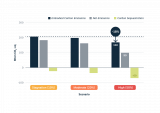
The construction sector is projected to exceed its carbon budget by 2026 using current construction practices.
But by constructing half of new residential buildings with bio-based materials, we can actually reduce CO2 emissions by 18% by 2030. That’s according to Metabolic's latest research, made possible through funding from Built by Nature. And if we consider carbon sequestration, we can even reduce the impact of the residential construction sector by 52%.
However, if solely focusing on carbon, we must be mindful not to shift the burden to other planetary boundaries. In our research, we discuss topics such as sustainable wood supply, climate change risks, and land use change. Based on our findings, we propose six steps to consider to realize a sustainable biobased construction sector.
Join SEWF23 week (9-13 October) in Amsterdam

The Social Enterprise World Forum (SEWF) is a global annual flagship event that brings together social entrepreneurs, policymakers, investors, academics and other impact-led professionals to strengthen impact entrepreneurship and encourage systemic change.
This year, the main event takes place in Amsterdam Noord and online and is co-hosted by Amsterdam Impact, the City of Amsterdam’s impact entrepreneurship initiative, and Social Enterprise NL.
Exploring the Future of Data in the Circular Economy: Highlights from Data Dilemma’s!
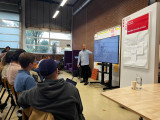
Amsterdam, a city with an ambitious goal of becoming fully circular by 2050, envisions a future where materials are continuously reused, waste is minimized, and resource cycles are closed. Achieving this vision hinges on the availability and analysis of data, which allows us to assess the extent to which materials are used, reused, or wasted. However, this data is often elusive, complex to analyse, and, in some cases, not even recorded. These challenges surrounding circular data were the focal point of our recent event, "Data Dilemma's: Collecting Data for the Circular Economy."
During Data Dilemma's, we explore the possibilities for using data and new technologies to address urban and societal challenges, with a focus on responsible digitalization. The goal is to use data to make cities more safe, clean and accessible. But what happens to all the data that is collected? Which dilemmas do we encounter when we collect (personal) data to improve the city.
Apparently, the topic of this edition of Data Dilemma’s was not only of interest to the Amsterdam Smart City team, since this event was completely sold out. This was no surprise, with the three incredible speakers we had lined up: Mersiha Tepic (municipality of Amsterdam), Maarten Sukel (Picnic), and Joris Bouwens (Metabolic).
Mersiha Tepic: Circular Economy Monitor Amsterdam
Mersiha Tepic, Senior Researcher at the Research & Statistics department of the Municipality of Amsterdam, demonstrated the Circular Economy Monitor Amsterdam. This essential tool tracks Amsterdam's progress towards a circular economy and identifies areas requiring further attention.
The monitor gives interesting insights. For instance, it shows that the environmental impact of food is four times as big as the impact of the built environment, even though the amount of materials used in the built environment is four and a half times larger than for food.
It reveals that food has a very high environmental per kilogram compared to materials from the built environment. This is interesting because it makes the total environmental impact of food much higher than the impact of the built environment, even though the built environment uses four times as much mass in materials than food.
For more information on the circular monitor and all its insights, you can check out their (Dutch) website.
During her presentation, Mersiha also delved into the data dilemma she faces in this project—the scarcity of data from significant commercial entities operating within the city. The lack of data from these key players poses a considerable challenge to Amsterdam's circular ambitions, and Mersiha's work sheds light on the importance of bridging these data gaps.
Maarten Sukel: Data-Driven Precision at Picnic
Our second speaker, Maarten Sukel, a Data Scientist at Picnic Technologies, showcased how the online supermarket Picnic leverages data. He presented an innovative approach that combines traditional data sources with images, written descriptions, and geographical information to predict customer preferences accurately. By doing so, Picnic not only optimizes its supply chain but also minimizes waste, aligning with the circular economy's core principles.
Maarten's insights provided a glimpse into how data-driven precision can be a game-changer in the pursuit of sustainability and waste reduction, and he also gave a convincing sales pitch on why you should be a customer of Picnic.
Joris Bouwens: The Promise of Digital Product Passports
Closing the event was Joris Bouwens, a Project Manager and Senior Consultant at Metabolic's Circular Industries team. Joris shed light on Digital Product Passports and their potential to revolutionize the circular economy. These passports offer a comprehensive digital record of a product's lifecycle and environmental impact, empowering consumers to make informed choices and encouraging responsible consumption and recycling.
Joris's presentation highlighted the immense opportunity presented by Digital Product Passports in getting as much value from used products as possible. To fully illustrate the potential of Digital Product Passport, Metabolic has created a visualization of the data flows in four sectors: Electronics, Chemicals, Apparel, and Construction. You can find these visualizations here.
We extend our gratitude to our amazing speakers for their invaluable contributions and to our engaged audience for their active participation in the discussion.
In the next edition of Data Dilemma’s we will delve into the fascinating world of the underground. What cables, tubes, and other assets can be found there, how is the data on these assets shared, and how can we improve collaboration? We hope to see you there on the 26th of October.
Do you have any suggestions for which Data Dillema's we should uncover next? Let us know in the comments below.
Hoe creëer je Levende Lerende Netwerken die impact hebben?
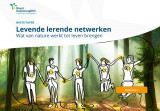
Hoe maak je de stap van gezamenlijk leren, naar samen echt dingen doen? Er is al veel over gezegd en geschreven... Communities of practice, smeden van allianties, enz enz... Vaak blijft het dan een beetje hangen bij het organiseren van een toffe sessie, vast met veel energie. En daarna gaat iedereen - als het goed is met nieuwe ideeën en inspiratie - weer verder met waar 'ie al mee bezig was. Vaak is dat al genoeg, maar zeker in transities wil je eigenlijk een stapje verder komen.
Is eigenlijk al wel voldaan aan een aantal belangrijke condities om het netwerk levend te maken en te houden?
Reflecterend op onze eigen praktijk, ontdekten we een aantal kenmerken die belangrijk en beïnvloedbaar zijn bij het bouwen van impactvolle levende lerende netwerken. Amsterdam Smart City zelf is zo'n voorbeeld, waarin we voortdurend met elkaar op zoek zijn naar hoe we onze samenwerking van betekenis kunnen laten zijn voor de duurzame transities in onze regio. De Green Deal Circular Festivals, het MRA Platform Smart Mobility, Sail Amsterdam, en het Initiatief Bewust Bodemgebruik zijn enkele andere voorbeelden van levende lerende netwerken. Ook hier zagen we telkens dat de volgende kenmerken van belang zijn om verder te komen, en om de stap te maken van samen leren, naar samen doen:
(1) Wederzijdse afhankelijkheid tussen deelnemers
(2) Beweging door gedeelde energie
(3) Diversiteit daagt uit
(4) Persoonlijke ontwikkeling, empathie, ego overstijgend
(5) Veilige ruimte om te leren en ontwikkelen
Op basis van onze ervaringen in de praktijk, hebben we onze kijk op het ontstaan, de kenmerken en het begeleiden van Levende Lerende Netwerken opgeschreven in een whitepaper. Wil je meer weten, dan kun je die downloaden via onderstaande link (naar beneden scrollen naar de download knop van de Levende Lerende Netwerken Whitepaper).
Tijdens het PGM Open Congres op 26 september organiseren we hierover een workshop voor programmamanagers (https://lnkd.in/gcRPv4V8). En, je kunt me natuurlijk altijd een berichtje sturen als je meer wilt weten!
Circularity in the Construction Sector: Experiences from The Netherlands and Denmark

On Thursday, September 7, Amsterdam Smart City hosted a knowledge exchange for a delegation of leaders and CEOs from Denmark’s construction sector. The exchange was part of a study program organized by the Construction Section of the Confederation of Danish Industry in partnership with the Danish Embassy in The Hague, to help transfer Dutch best practices for circular construction to Denmark.
The exchange provided an opportunity for Dutch and Danish colleagues to learn from each other’s experiences on how to transition the construction sector to a more sustainable state. This is imperative since the construction sector is responsible for approximately 10% of CO₂ emissions, and a third of all waste streams in both countries. At the same time, both countries have high ambitions for transitioning to sustainability: the Netherlands aims to transition to a fully circular economy by 2050, while Denmark aims to reduce greenhouse gas emissions by 70% by 2030.
After an introduction to the Amsterdam Smart City program, Merlijn Blok from Metabolic shared the experience of Amsterdam in transitioning to a circular built environment. Merlijn highlighted several projects and best practices including:
- De Ceuvel: In 2012, Metabolic teamed up with a group of architects to develop a former polluted shipyard into a “clean technology playground” by repurposing discarded house boats into workspaces for creative entrepreneurs. The project fused sustainability, technology, and art, firmly planting the seed for more creative and circular area developments in Amsterdam North and beyond.
- Schoonschip: Building on the experience and lessons from De Ceuvel, Metabolic got involved in a community-driven project that aimed to build a sustainable floating community. Driven entirely by future residents, Schoonschip was built with a high ambition of circularity, with special attention paid to biobased materials which are key to reducing the environmental footprint of construction projects.
- Roadmap Circular Land Tendering: Scaling up isolated circular construction projects requires dedicated instruments to stimulate, measure and mandate circularity in the built environment, for instance through procurement. The Roadmap Circular Land Tendering is one of city of Amsterdam’s main instruments embedding the principles of circular construction in tender procedures. With it, the city of Amsterdam wants to contribute to the development of a national standard for circular building.
Central to the discussion was the question of how to move beyond ambitions towards making concrete and measurable progress on circularity in the built environment. On this topic, it was inspiring to learn from the Danish experience. The delegates shared that the Danish government has developed a “National Strategy for Sustainable Construction” which limits the CO₂ emissions permitted in construction projects, with new requirements being phased into the building code in 2023. The regulations apply to new buildings of more than 1,000 m2 and set a limit of 12kg CO₂-eq/m2/year based on Life Cycle Assessment (LCA) over 50 years. This limit is expected to be tightened in the upcoming years, thereby forcing the construction sector to incrementally decarbonize over the next decade. Such mandates are foreseen but not yet implemented in the Netherlands, providing an opportunity to learn from Denmark’s trailblazing approach. However, the Danish colleagues already shared some words of caution if Netherlands should adopt a similar approach: since the Danish regulation limits CO₂ impact per square meter, the regulation does little to incentivize construction of smaller dwellings which is one of the most important, though often overlooked measures in reducing the impact of the construction sector. As Danish colleagues explained, the overarching trend in Denmark is towards construction of larger dwellings, which is fundamentally at odds with the country’s sustainability goals. Other mechanisms are therefore needed to mandate more compact development.
The exchange provided valuable insights and cross-pollination of approaches between Danish and Dutch colleagues on a topic central to the transition to the circular economy. As leaders in the sustainability transition, the Netherlands and Denmark have a tremendous opportunity and responsibility to showcase the way to circular construction and to help scale this approach internationally.
<em>Are you working on innovative and transferable policies which can accelerate the transition to circular construction and sustainable built environment? Or do you have a circular project or challenge you would like to share with the Amsterdam Smart City network? Share your reflections and experiences in the comments below or send an email to noor@amsterdamsmartcity.com to discuss possibilities for collaboration.</em>
Demoday #20: Plastic, we love it!
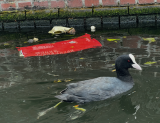
Ons plasticverbruik stijgt nog steeds drastisch
Technisch gezien zijn alle oplossingen voorhanden om ons plasticgebruik drastisch te verminderen in zowel productieprocessen en het voorkomen en/of verwijderen van microplastics in de natuur. Toch verandert er in de praktijk bijna niets. Er zijn veel initiatieven, maar de vraag is of die een daadwerkelijk verschil maken, want als we naar de cijfers kijken stijgt ons plasticgebruik nog steeds drastisch. Sinds 2000 is ons plasticverbruik zelfs verdubbeld!
Waarom verandert er zo weinig?
Hoe kan het dat we, ondanks dat we weten hoe slecht het is voor onszelf en het milieu, er niets significant veranderen aan ons plasticgebruik? En wat kunnen we doen om het plasticprobleem nu wél echt aan te pakken in de regio? Deze vragen stonden centraal tijdens de werksessie ‘Plastic, we love it.’ Tijdens de werksessie hebben de aanwezige strategische denkkracht gemobiliseerd om samen tot nieuwe inzichten komen in de keten van plasticgebruik én nieuwe oplossingsrichtingen met elkaar te bedenken.
Gek, gekker, goed!
Als we doorgaan zoals we nu doen, gaat het dus niet lukken. Daar zijn we het met elkaar over eens. Maar hoe dan wel? Om dat met elkaar helder te krijgen, hebben we eerst een aantal echt onrealistische en misschien zelfs wel onethische oplossingen bedacht. En dat hebben we geweten. Van ‘geen kinderen meer krijgen’ tot aan ‘recyclepolitie op de hoek van elke straat’ en het ‘verbieden van alle plastics’ werden geopperd. En probeerden we zelfs daar nog een schepje bovenop te doen. Natuurlijk niet om uit te voeren, maar wel om daarna weer te kunnen komen tot goede ideeën. We hielpen elkaar en werkten elkaars ideeën en oplossingsrichtingen uit tot realistische en goede ideeën.
Waar ligt jouw invloed?
Maar ideeën bedenken is makkelijk, maar de werkelijke uitdaging ligt bij het komen van idee naar plan naar uitvoering. Dus wat je kun zelf doen? Hoe kan ík een werkelijke bijdrage leveren aan het oplossen van dit complexe vraagstuk? Samen met de groep hebben we gekeken naar daar waar onze eigen invloed zit. De groep kwam met mooie concrete ideeën waar we zelf aan mee kunnen werken en aan kunnen jagen. In de top 3 stonden een bewustwordingscampagne, een plastic politie, lobby richting de politiek door bovenregionaal samen te werken en het belonen van goed gedrag. We kijken terug op een mooie werksessie met waardevolle uitkomsten en kijken uit naar het vervolg en natuurlijk vooral naar een echt resultaat: geen plastic meer in de natuur en in ons voedsel.
Marten Boels, dank voor het inbrengen van dit relevante en belangrijke onderwerp!
Metabolic CEO, Eva Gladek, was nominated for the Big Little Talk at Circularity 23!

Creating a sustainable planet for future generations is essential, and understanding our impacts on nature is a critical step toward achieving this goal.
Unfortunately, measuring impact on nature is complicated and requires specific expertise. We need to combine impact data with geospatial analysis to really see where the different activities along companies’ value chains are taking place, and how those impact nature and biodiversity locally.
By voting for Eva's Big Little Talk, you will Metabolic showcase the importance of nature assessments on the big stage at Circularity 23.
It takes only 1 minute, vote for our video in the link below.
#circularity23 #LinkByMetabolic #natureassessment
The 100 Intelligent Cities Challenge: Looking Back & Looking Forward

Over the past 2.5 years, the 100 Intelligent Cities Challenge (ICC) of the European Commission’s DG GROW (Directorate General for Internal Market, Industry, Entrepreneurship and SMEs) brought together 136 cities in a peer network aimed at transitioning to the green economy.
The main beneficiaries of the program were the 80 core cities that received policy advice and project implementation support. Additionally, all ICC participants engaged in collective learning and knowledge exchange during a series of “City Labs”.
The Role of Amsterdam Metropolitan Region (MRA)
The MRA, represented by Amsterdam Economic Board and Amsterdam Smart City program participated in the ICC as one of sixteen mentors, sharing experiences and best practices throughout the ICC journey. Thirteen experts and stakeholders from MRA contributed to sixteen knowledge-sharing sessions on topics such as local green deals, multi-stakeholder governance, up-skilling & re-skilling, smart mobility, circular economy, and citizen-led initiatives. Amsterdam Smart City and Amsterdam Economic Board also shared knowledge and advice in bilateral meetings with several ICC core cities and participated in the ICC Advisory Board.
Closing Conference
The closing conference of the first phase of the ICC took place in Barcelona during the Smart City Expo World Congress on November 15-16. The conference brought together 40 European mayors, vice-mayors, political representatives, and city leaders. Marja Ruigrok, vice-mayor of the city of Haarlemmermeer, shared MRA’s experience and approach on multi-stakeholder collaboration and several Green Deals initiated by Amsterdam Economic Board. The development of Local Green Deals has become a cornerstone of the ICC which supported 42 cities in designing Green Deals through the development of a Green Deals Blueprint, and tailored support.
Looking Forward to Phase 2 of ICC
In Barcelona, the European Commission confirmed that the second phase of the ICC initiative will start in 2023. Phase 2 will focus on strengthening the existing network of cities and improving the ICC methodology for city-to-city learning, collaboration, and capacity building. Phase 2 also aims to ensure and improve complementarity between the ICC and other EU initiatives, particularly the 100 Climate Neutral and Smart Cities Mission.
For more information about the first phase of the ICC, visit:
• ICC Website: https://www.intelligentcitieschallenge.eu/
• ICC Project on ASC platform: https://amsterdamsmartcity.com/updates/project/the-100-intelligent-cities-challenge
The Circularity Gap Report for the Built Environment
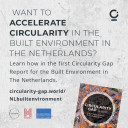
The first Circularity Gap Report for the Built Environment in The Netherlands has launched!
The Netherlands has set an ambitious goal: a circular building sector by 2050. However, the built environment in the Netherlands is a massive motor for downcycling. Only 8% of the total material consumption comes from secondary materials.
This report by Metabolic, C-creators, Goldschmeding Foundation and Circle Economy shows new insights and specific actions for businesses, policymakers, urban planners and labour unions to accelerate circularity in the sector.
Get the overview from the summary in Dutch or download the full report in English below.
Risks and opportunities of digitization in healthcare

The 21st episode of the Better cities – the contribution of digital technology-series is about priorities for digital healthcare, often referred to as eHealth.
The subject is broader than what will be discussed here. I won't talk about the degree of automation in surgery, the impressive equipment available to doctors, ranging from the high-tech chair at the dentist to the MRI scanner in hospitals, nor about researching microbes in air, water and sewerage that has exploded due to the covid pandemic. Even the relationship with the urban environment remains somewhat in the background. This simply does not play a prominent role when it comes to digitization in healthcare. The subject, on the other hand, lends itself well to illustrate ethical and social problems associated with digitization. As well as the solutions available in the meantime.
The challenge: saving costs and improving the quality of care
The Netherlands can be fortunate to be one of the countries with the best care in the world. However, there are still plenty of challenges, such as a greater focus on health instead of on disease, placing more responsibility for their own health on citizens, increasing the resilience of hospitals, paying attention to health for the poorer part of the population, whose number of healthy life years is significantly lower and, above all, limiting the increase of cost. Over the past 20 years, healthcare in the Netherlands has become 150% more expensive, not counting the costs of the pandemic. Annual healthcare costs now amount to € 100 billion, about 10% of GDP. Without intervention, this will rise to approximately €170 billion in 2040, mainly due to an aging population. In the meantime, healthcare costs are very unevenly distributed: 80% of healthcare costs go to 10% of the population.
The most important task facing the Netherlands and other rich countries is to use digitization primarily to reduce healthcare costs, while not forgetting the other challenges mentioned. This concerns a series of - often small - forms of digital care. According to McKinsey, savings of €18 billion by 2030 are within reach, if only with forms of digitization with proven effect. Most gains can be made by reducing the administrative burden and shifting costs to less specialized centers, to home treatment and to prevention.
Information provision
There are more than 300,000 health sites and apps on the Internet, which provide comprehensive information about diseases, options for diagnosis and self-treatment. More and more medical data can also be viewed online. Often the information on apps is incomplete resulting in misdiagnosis. Doctors in the Netherlands especially recommend the website Thuisarts.nl, which they developed themselves.
Many apps use gamification, such as exercises to improve memory. A good example of digital social innovation is Mirrorable, a program to treat children with motor disorders because of brain injury. This program also enables contact between parents whose inputs continuously help to improve exercises.
Process automation
Process automation in healthcare resembles in many respects automation elsewhere, such as personnel, logistics and financial management. More specific is the integrated electronic patient file. The Framework Act on Electronic Data Exchange in Healthcare, adopted in 2021, obliges healthcare providers to exchange data electronically and prescribes standards. However, data exchange will be minimal and will only take place at a decentralized level to address privacy concerns. The complexity of the organization of health care and the constant discussions about the content of such a system were also immense obstacles. That's a pity because a central system lowers costs and increases quality. Meanwhile, new technological developments guarantee privacy with great certainty. For example, the use of federated (decentralized) forms of data storage combined with blockchain. TNO conducts groundbreaking research in this area. The institution applies the principles of federated learning along with the application of multi-party computation technology. These innovative technologies enable learning from sensitive data from multiple sources without sharing this data.
Video calling
The recent eHealth monitor of the RIVM shows that by 2021 almost half of all doctors and nurses had had contact with patients with video calling, while this hardly happened in 2019. Incidentally, this concerns a relatively small group of patients. In the US there was an even larger increase, which has now been converted into a sharp decline. It seems that in the US primary health care is reinventing itself. Walgreens, the largest US drugstore chain, will begin offering primary care in 1000 of its stores. Apparently, in many cases, physical contact with a doctor is irreplaceable, even if (or perhaps because) the doctor is relatively anonymous.
Video calling is not only important for care provider, but also for informal caregivers, family and friends and help to combat loneliness. Virtual reality (metaverse!) will further expand the possibilities for this. TNO is also active here: The TNO media lab is developing a scalable communication platform in which the person involved (patient or client), using only an upright iPad, has the impression that the doctor, district nurse or visitor is sitting at the table or on the couch right in front.
Self-diagnosis
The effectiveness of a remote consultation is of course served if the patient has already made a few observations him- or herself. 8% of patients with chronic conditions already do this. There is a growing range of self-tests available for, for example, fertility, urinary tract infections, kidney disorders and of course Covid-19. There are also home devices such as smart thermometers, mats that detect diabetic foot complications, and blood pressure meters; basically, everything that doctors often routinely do during a visit. The GGD AppStore provides an overview of relevant and reliable apps in the field of health.
Wearables, for example built into an i-watch, can collect part of the desired data, store it for a longer period and, if necessary, exchange it with the care provider.
More advanced are the mobile diagnosis boxes for emergency care by nurses on location, such as ambulances. With a fast Internet connection (5G), specialist care providers can watch if necessary.
A small but growing group of patients, doctors, and researchers with substantial financial support from Egon Musk sees the future mainly in chip implants. This would allow not only more complete diagnoses to be made, but also treatments to be carried out. Neuralink has developed a brain implant that improves communication with speech and hearing-impaired people. The Synchron brain implant helps people with brain disorders perform simple movements. For the time being, the resistance to brain implants is high.
Remote monitoring
Meanwhile, all these low-threshold amenities can lead us to become fixated on disease rather than on health. But what if we never had to worry about our health again? Instead, the local health center watches over our health thanks to wearables: Our data is continuously monitored and analyzed using artificial intelligence. They are compared with millions of diagnostic data from other patients. By comparing patterns, diseases can be predicted in good time, followed by automated suggestions for self-treatment or advice to consult a doctor. Until then, we have probably experienced nothing but vague complaints ourselves. Wouldn't that be an attractive prospect?
Helsinki is experimenting with a Health Benefit Analysis tool that anonymously examines patients' medical records to evaluate the care they have received so far. The central question here is can the municipality proactively approach people based on the health risk that has come to light because of this type of analysis?
Medics participating in a large-scale study by the University of Chicago and the company Verify were amazed at the accuracy with which algorithms were able to diagnose patients and predict diseases ranging from cardiovascular disease to cancer. In a recent article, oncologist Samuel Volchenboom described that it is painful to note that the calculations came from Verify, a subsidiary of Alphabet, which not only used medical data (with patients’ consent), but also all other data that sister company Google already had stored about them. He adds that it is unacceptable that owning and using such valuable data becomes the province of only a few companies.
Perhaps even more problematic is that these predictions are based in part on patterns in the data that the researchers can't fully explain. It is therefore argued that the use of these types of algorithms should be banned. But how would a patient feel if such an algorithmic recommendation is the last straw? It is better to invest in more transparent artificial intelligence.
Implementing digital technology
Both many patients and healthcare professionals still have doubts about the added value of digital technology. The media reports new cases of data breaches and theft every day. Most people are not very confident that blockchain technology, among other things, can prevent this. Most medical specialists doubt whether ICT will reduce their workload. It is often thought of as some additional thing. Numerous small-scale pilot projects are taking place, which consume a lot of energy, but which are rarely scaled up. The supply of digital healthcare technologies exceeds their use.
Digital medicine will have to connect more than at present with the needs of health professionals and patients. In addition to concerns about privacy, the latter are especially afraid of further reductions in personal attention. The idea of a care robot is terrifying them. As should be the case with all forms of digitization, there is a need for a broadly supported vision and setting priorities based on that.
Against this background, a plea for even more medical technology in our part of the world, including e-health, is somewhat embarrassing. Growth in healthy years due to investment in health care in developing countries will far exceed the impact of the same investment in wealthy countries.
Nevertheless, it is desirable to continue deliberately on the chosen path, whereby expensive experiments for the benefit of a small group of patients have less priority in my opinion than investments in a healthy lifestyle, prevention, and self-reliance. Healthcare cannot and should not be taken over by robots; digitization and automation are mainly there to support and improve the work of the care provider and make it more satisficing and efficient.
One of the chapters in my e-book Future cities, always humane, smart if helpful, also deals with health care and offers examples of digital tools. In addition, it pays much more contextual information about the global health situation, particularly in cities. You can download by following the link below. The Dutch edition is here.
The interconnected city with nature, communities and resources

In December, the Metabolic Cities team created a series of 3 articles on what future cities can become based on interconnections with nature, communities and resources.
If you haven’t already, take a look and tell us what you think.
An inclusive nature city allows species to thrive: https://www.metabolic.nl/news/interconnected-city-nature/
Interconnected communities, vital for healthy cities: https://www.metabolic.nl/news/interconnected-city-community/
Reconnecting to resources brings operations within planetary boundaries: https://www.metabolic.nl/news/interconnected-city-resources/
Hoe zorgen we er samen voor dat er in de toekomst voldoende drinkwater aanwezig blijft in onze regio?

Drinkwater is wereldwijd een schaars goed. In Nederland is onze drinkwatervoorziening gelukkig goed geregeld. En toch. Als gevolg van
onze veranderende wereld stapelen de transities op. Zekerheden die we lang voor lief namen worden omgegooid. Onze steden groeien, wat nieuwe kansen brengt, maar ook nieuwe uitdagingen. Dat betekent ook iets voor onze
drinkwatervoorziening. Ons gebruik neemt toe en het aanbod staat onder druk.
Binnen de Provincie Flevoland is men aan het onderzoeken wat er nu al voor nodig is om dit probleem een halt toe te roepen. Momenteel zien we de vraag naar drinkwater stijgen, de drukte in de ondergrond toenemen en door klimaatverandering (denk aan droogte en hete zomers) het watergebruik stijgen. Om voldoende drinkwater van een goede kwaliteit te garanderen moeten we werken aan een systeemverandering. Waterbesparing moet worden gestimuleerd en laagwaardig gebruik van hoogwaardige kwaliteit water moet worden voorkomen.
Het huidige drinkwatergebruik bestaat voor ca. 70% huishoudelijke- en 30% zakelijke gebruikers (regio afhankelijk). Hoe maken we bij deze doelgroepen waterbesparing de norm? En hoe zorgen we ervoor dat de kwaliteit van het water bepalend is voor het gebruik? Dit zijn vraagstukken die in de toekomst steeds relevanter worden, maar ook nú al onze aandacht vragen.
Halverwege maart zal er binnen de Provincie Flevoland een Adviseur Drinkwatertransitie aan de slag gaan die zich met deze vragen bezighoudt.
We vragen jou om hulp!
Samen met de Provincie Flevoland zoeken we daarom alvast de ideeën, ervaringen en het draagvlak van het netwerk op. We zijn op zoek naar actuele kennis over dit onderwerp en mogelijke oplossingen. Daarnaast zijn we ook specifiek geïnteresseerd in ideeën om nu al urgentie te creëren voor dit onderwerp, ondanks dat het mogelijk pas in de toekomst gaat spelen.
Ben jij een expert op het thema, of heb jij relevante ideeën en ervaringen uit andere onderwerpen? Laat je reactie achter in de comments!
Stay up to date
Get notified about new updates, opportunities or events that match your interests.

